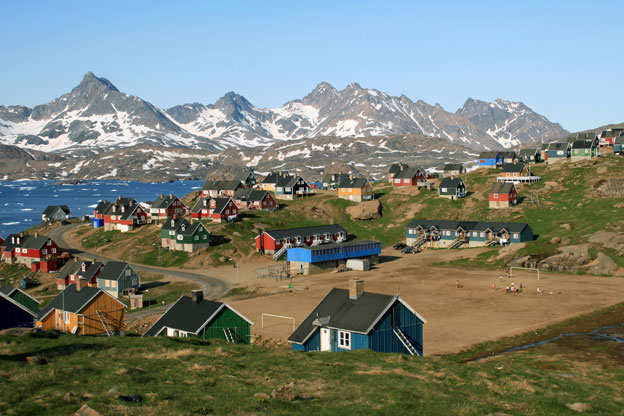by Naomi Sweetman
Program Coordinator, Alaska Department of Public Safety
This document is written to discuss the value of utilizing Crime Prevention Through Environmental Design (CPTED) concepts in rural Alaska to create healthy communities and reduce crime.
Rural Alaska is predominately populated by Alaska Natives, a diverse group of indigenous peoples who have distinctively different cultures. Further, these groups have different histories with respect to their contact with Russian explorers and later the pioneers that migrated to Alaska for the abundant resources found here. However, all of these groups share with each other and those of the lower 48 American Indians values and beliefs that prioritize family and community over the individual, sharing of resources and a deep connection with the natural world which is tied to their spirituality and culture.
For many years, Alaska Natives, particularly in rural Alaska have been plagued with federal policies that have served to contribute to the erosion of their culture. These policies and practices have led to a crisis point in rural Alaska. Alaska leads the nation in substance abuse, domestic violence, sexual assault and suicides. Within Alaska, rural Alaska leads the state in the incidents of these social problems. This has led to entire communities where substance abuse and violence is the norm and every person has been impacted by more than one suicide.
For generations the federal and state governments have provided additional support in rural Alaska in the form of assistance building homes and other structures, energy assistance and additional supportive services. These were designed to offset the high cost of construction and living in rural Alaska due to the soaring costs associated with obtaining goods and services in these communities.
Because the structures and homes that are built in rural Alaska are often subsidized by a governmental entity, the homes that are built are typical of those seen in many low income housing developments in larger communities. Frequently, these homes do not meet the needs of the people living in them. In many villages, two or more extended families may be living in a three bedroom one bath home.
As one travels throughout rural Alaska, one can see a significant diversity in the villages and how the communities are built. Some villages appear to have been well thought out, with the community service structures centralized and easily accessible to everyone. Other communities appear to have been built in a random pattern, almost as if dice were rolled each time a new building was considered. These communities often have public service structures such as the village store, situated far from where community members are living, making access difficult. Crime Prevention Through Environmental Design (CPTED) is a concept that looks at the design of a community as well as physical structures to increase accessibility for the legitimate user and decrease the accessibility for the unwanted user. In other words, the concepts work to make the space more friendly for the law abiding citizen and unfriendly for criminal activity.
CPTED uses territoriality, natural surveillance, physical maintenance and access management in evaluating and designing structures. These principles are used to create safe spaces.
Territoriality is utilized to identify when the line is crossed from public to semi-private to private space. In many neighborhoods across the country, the sidewalk is considered public space. Often people will put up fencing or shrubbery that denotes the move from public space (the sidewalk) to semi-private space (the yard) and when one steps into the home they have entered private space. In close quarters, such as a large city, there may not be semi-private space. However, if a business puts a red carpet on the sidewalk in front of their building, most people will walk around the carpet, treating it as semi-private space. In rural Alaska, there is often no distinction between public and semi-private space, particularly in the wintertime when boardwalks are covered in snow.
Natural Surveillance is utilized for the protection of the space. For example, home owners are encouraged to keep large shrubbery away from the home which creates hiding spaces. Keeping windows unblocked, tree limbs and shrubs trimmed up 5 feet high so that there is good visibility from the street onto the property and from the home out to the street helps to create safer spaces. A great example of this is the move of America to suburban living. Prior to that, many people owned a business and lived above their business in the city. The move to suburban America and new zoning laws created a situation where at night in the business district there was no one present and no natural surveillance, creating a virtual criminal haven. When it became too expensive for the mother to stay home, suburban housewives entered the workforce, leaving many suburban neighborhoods vacant during the day and setting up a situation where theft rates increased in suburban America. Lighting is also critical when considering natural surveillance.
Physical Maintenance works on the principle of the “broken window theory”. Much research has been done to show that even the individual who does not typically participate in vandalism will do so when the structure is rundown. Additionally, this lack of keeping up with maintenance suggests to the viewer that the owner does not care for the building.
Access Management works on the basis of how individuals access the structure. The use of signage and other techniques are used to guide the individual to the appropriate points of access.
CPTED principles go beyond simply evaluating existing structures. The concepts are also used at the planning stages of neighborhoods and communities, from architecture to zoning regulations. There are many examples of the use of CPTED throughout the world. Europe and Canada use the concepts extensively to create safe spaces for residents and visitors. In this country, CPTED is becoming more widely utilized in government facilities, schools, universities and more recently the revitalization of neighborhoods. When used properly, not only is the space created safer for the individuals that regularly utilize the space but also many of the social problems that were present in these spaces have disappeared. Further, utilizing the CPTED principles typically do not have additional costs associated with them.
A few years ago, this writer contracted with consultants to conduct CPTED assessments at four high risk schools in the Matsu Borough School District. The bidders were required to produce examples of reports they had written for other school districts. One particularly impressive report discussed a school that had drug dealers and prostitutes who were working on a corner next to the elementary school being assessed. Simply changing the light bulb to a type of bulb that made it difficult for the drug dealers to count their money and making the prostitutes look like they were skeletons solved the problem and moved the crime away from the school. Further, the prostitutes were taking the ‘johns’ behind the school and leaving used condoms behind. School children were asked to paint a mural with hand and foot prints and kid sayings and consequently the ‘johns’ stopped going behind the school for sexual activity. The reports drafted by these consultants for the school district presented recommendations that often could be implemented by the Principals at the school and cost little to no additional money to implement.
CPTED works on the basis of understanding what the users of the space require to adequately utilize the space. This requires some preparation prior to building a space, typically in the form of interviewing and talking with the users of the space. In rural Alaska there are no significant building codes or zoning regulations. Further, people who live in a community are not interviewed to determine what their needs are or how they utilize their space. This results in homes and communities that do not meet the needs of the individuals living in them.
Diggs Town, a low income neighborhood in Norfolk Virginia, was typical of most low income projects with high rise apartments, residents that moved in and out of the apartments due to changes in their income and high crime rates that resulted in 30 calls per day for assistance. The apartments required change, so HUD came in and utilized CPTED principles to rebuild the community. Residents were interviewed to determine what they needed and how they utilized the space, zoning regulations were adjusted, and streets were reworked. Residents reported that they would like to be able to stay in their home if their income went up, they wanted a home rather than an apartment, and they would like a yard. Zoning was changed that required homes built in the neighborhood to be townhouse style homes, the living space must be in the front facing the street, every house had a porch, every house had a fence and a shed painted the same color as the house. They also moved an officer into the neighborhood and built a community center. What they found was that residents could watch the street, creating natural surveillance; people took care of their homes and their yards. Further, calls for service went down to two to three per week. Residents were not required to move if their income increased, however, they had to put the additional money in a savings account. Adult informational classes were offered at the community center including how to buy a home. Forty percent of the residents moved out of the community to buy a house.
This is impressive; it suggests that if residents receive housing that meets their needs and makes sense with how they utilize the space, people will begin to take pride in their home and take care of their space. Further, it suggests that by designing homes and neighborhoods that meet the needs of the larger community, social problems previously experienced go away or move to other areas.
This makes sense if you consider Maslow’s Hierarchy of Needs. On the bottom rung are the basic life needs: food, shelter, warmth, etc. If these needs are not met, then the individual is unable to move to the next rung of the ladder, which is the need for safety. If there are nineteen people living in a two to three bedroom, one bath home, and tripping over each other, these basic needs are not being met and nobody can move to the next stage in the hierarchy, that of safety. When entire community’s basic needs are not being met, social problems become rampant. Further, given the deep connection that most Alaskan Natives feel to their community and, when they look around trying to meet those basic needs, they realize that there is nothing available in their village to meet them. They may become hopeless which can lead to substance abuse and suicide.
The Army Corp of Engineers and HUD have extensive experience working in other communities across the country applying CPTED principles and in many cases the policies and rules that govern these agencies encourage them to utilize CPTED principals when possible. In consultation with experts on the topic, the Army Corp of Engineers and HUD often have to be asked by local leaders to apply CPTED principles.
It is difficult to provide specific examples of how a community might be built because each village and the needs of the residents are very different. An example might be of a village where the school, community store and other village services are located at the center of the community and housing units surround these services. Multi-family homes will need to be creatively adapted to accommodate extended families while still keeping heating costs down. These homes might have a large common area that includes gathering and cooking space, with more private living and sleeping spaces for the individual families attached. The homes may also include covered storage for 4-wheelers/snow machines used for subsistence living and a shed or other structure that serves as a space to process various food, hides, bones and other items gathered throughout the year.
The ramification of the application of these principles in rural Alaska cannot be over stated. This writer proposes that we take the lead in encouraging the widespread use of CPTED in rural Alaska starting with those communities where the entire community needs to move due to erosion. HUD, the Army Corp of Engineers and the State of Alaska will need to fund the lion share of these moves. Bringing in the CPTED principles, interviewing the residents for their needs and how they utilize space, will not significantly increase the cost of each move. Further, shifting the design of the community and the homes to accommodate the needs of the residents will likely not cost additional funds and could potentially produce savings. It is quite possible that by taking these steps, the community may step up and become partners in the move process rather than the contentious relationships that currently exist.








